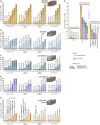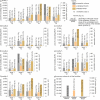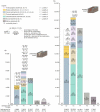Engineering-geological study of relationships between soil and rock workability, type and volume of excavated materials, and earthwork costs (six case studies)
- PMID: 37009813
- PMCID: PMC10068602
- DOI: 10.1038/s41598-023-31859-3
Engineering-geological study of relationships between soil and rock workability, type and volume of excavated materials, and earthwork costs (six case studies)
Abstract
The engineering-geological study deals with the study of significance and relationship of soil and rock workability (factor representing the engineering-geological structure of rock massif) and the remaining earthwork parameters influencing the cost of construction work, such as excavation type and its technology, and excavated cubic volume. The comparative tool was the cost of earthwork as it reflects the real value of the given parameters during the implementation of earthwork. Soil and rock workability is the most important parameter of rock massif engineering-geological structure during any earthwork. The investor pays the contractor for earthwork based on workability classes which have their accounting value expressed as a volume unit of earthwork per particular project. The research results arise from a comparison of 6 sewer system construction project case studies in the north-east of the Czech Republic. The research shows that the most important factor during the implementation of earthwork is the specific engineering-geological structure (52%), which reflects in the parameter of soil and rock workability classes, using which all earthwork is priced. The second most important factor (33%) is the type of excavation and its technology. The least important is the excavated cubic volume (15%), which means the overall cubic volume of earthwork. The results were obtained within three evaluation approaches, where the comparison unit was one cubic meter of excavated volume during earthwork.
© 2023. The Author(s).
Conflict of interest statement
The authors declare no competing interests.
Figures












References
-
- Griffiths JS, Radford T. An introduction to earthworks in Europe. Geol. Soc. Lond. Eng. Geol. Spec. Publ. 2012;26(1):1–4.
-
- Gunn, D. A., Reeves, H. J., Chambers, J. E., Ghataora, G. S., Burrow, M. P. N., Weston, P., Lovell J.M., Nelder L., Ward D., Smith, R. T. (2008). New geophysical and geotechnical approaches to characterise under utilised earthworks. Adv. Transp. Geotech., 313–320. CRC Press.
-
- Herle V. Czech standards and specification for earthworks. Geol. Soc. Lond. Eng. Geol. Spec. Publ. 2012;26(1):61–65.
-
- Meurant G. Soil Mechanics of Earthworks, Foundations and Highway Engineering. Elsevier; 2013.
-
- Azahar, M. A., Mahadi, N. F. Z., Rusli, Q. N., Narendranathan, N., Lee, E. C. (2019, April). Use of geophysics for site investigations and earthworks assessments. in IOP Conference Series: Materials Science and Engineering (Vol. 512, No. 1, p. 012007). IOP Publishing.
Grants and funding
LinkOut - more resources
Full Text Sources

